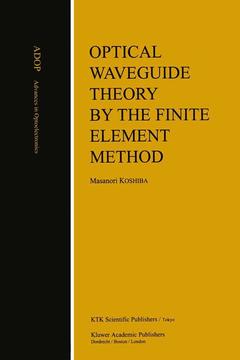Description
Optical Waveguide Theory by the Finite Element Method, Softcover reprint of the original 1st ed. 1992
Advances in Opto-Electronics Series, Vol. 5
Author: Koshiba Masanori
Language: English
Approximative price 52.74 €
In Print (Delivery period: 15 days).
Add to cart
Publication date: 11-2012
272 p. · 16x24 cm · Paperback
272 p. · 16x24 cm · Paperback
Description
/li>Contents
/li>
Recent advances in the field of guided-wave optics, such as fiber optics and integrated optics, have included the introduction of arbitrarily-shaped optical waveguides which, in many cases, also happened to be arbitrarily inhomogeneous, dissipative, anisotropic, and/or nonlinear. Most of such cases of waveguide arbitrariness do not lend themselves to analytical so lutions; hence, computational tools for modeling and simulation are es sential for successful design, optimization, and realization of the optical waveguides. For this purpose, various numerical techniques have been de veloped. In particular, the finite element method (FEM) is a powerful and efficient tool for the most general (i. e. , arbitrarily-shaped, inhomogeneous, dissipative, anisotropic, and nonlinear) optical waveguide problem. Its use in industry and research is extensive, and indeed it could be said that with out it many optical waveguide problems would be incapable of solution. This book is intended for students, engineers, designers, and techni cal managers interested in a detailed description of the FEM for optical waveguide analysis. Starting from a brief review of electromagnetic theory, the first chapter provides the concepts of the FEM and its fundamentals. In addition to conventional elements, i. e. , line elements, triangular elements, tetrahedral elements, ring elements, and triangular ring elements which are utilized for one-dimensional, two-dimensional, three-dimensional, axisymmetric two dimensional, and axisymmetric three-dimensional problems, respectively, special-purpose elements, such as isoparametric elements, edge elements, infinite elements, and boundary elements, are also introduced.
Preface. 1. Finite Element Method. 2. Planar Optical Waveguides. 3. Optical Channel Waveguides. 4. Optical Fibers. 5. Polarization-Maintaining Optical Fibers. 6. Optical Gratings. 7. Optical Waveguide Discontinuities. 8. Nonlinear Optical Waveguide. 9. Optical Solitons. 10. Quantum Well Structures.
© 2024 LAVOISIER S.A.S.
These books may interest you

Optical Materials and Applications 178.41 €



